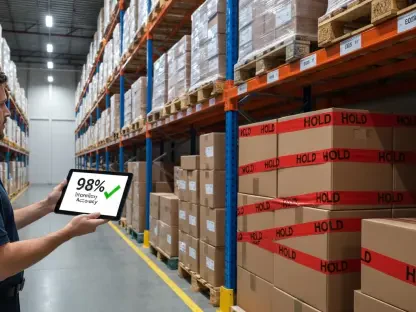Today, we’re thrilled to sit down with Rohit Laila, a veteran in the logistics industry with decades of experience spanning supply chain management and delivery operations. Rohit’s passion for integrating technology and innovation into warehouse processes has made him a sought-after expert in optimizing efficiency. In this interview, we dive into the critical role of picking strategies in warehouse operations, exploring how different methods impact labor costs, customer satisfaction, and overall workflow. We’ll also unpack the nuances of various picking techniques and the key factors that guide their selection in diverse operational settings.
Can you share why picking strategies are so pivotal to warehouse operations?
Absolutely. Picking is often the heart of warehouse operations because it’s where most of the labor effort is concentrated—sometimes up to two-thirds of the workforce is involved. A well-chosen picking strategy can streamline the entire process, cutting down on time spent retrieving items and minimizing errors. This directly boosts efficiency, reduces operational costs, and ensures orders are fulfilled faster, which is crucial for maintaining a competitive edge in today’s fast-paced market.
How does selecting the right picking method influence labor costs?
The right picking method can significantly lower labor costs by reducing the time workers spend moving around the warehouse. For instance, methods like batch or cluster picking minimize travel by grouping similar orders, so workers aren’t zigzagging across the facility for every single item. Less travel means more picks per hour, which translates to better productivity without necessarily increasing headcount. On the flip side, a poor method can inflate costs through wasted time and overstaffing.
In what ways does an effective picking strategy enhance customer satisfaction?
Customers today expect quick, accurate deliveries, and the picking strategy plays a huge role in meeting those expectations. When orders are picked efficiently and without errors, they’re shipped out faster and arrive on time. Accuracy is key—nobody wants the wrong item or a delayed shipment. A solid picking approach, like zone picking, can improve consistency and reduce mix-ups, which keeps customers happy and builds trust in your operation.
What are the main factors a warehouse manager should weigh when deciding on a picking method?
It’s all about understanding your specific operation. Managers need to look at the facility’s layout—how much space there is and how it’s organized. Then, consider the product mix: Are you dealing with small, fast-moving items or bulky, slow-moving goods? Order volume is another big factor; high-volume operations need methods that handle multiple orders efficiently. Labor availability also matters—do you have enough skilled workers to execute a complex method? And finally, goals like speed versus accuracy should guide the choice. It’s a balancing act.
Can you walk us through the discrete picking method and explain where it’s most effective?
Discrete picking, or single-order picking, is straightforward: a worker picks all items for one order before moving to the next. It’s incredibly accurate since there’s no mixing of orders, which makes it ideal for smaller operations or those with low order volumes, like a regional retailer restocking stores. It works best where precision trumps speed, but in larger facilities, it can be inefficient due to the constant travel for just one order at a time.
How does batch picking stand out from discrete picking, and which operations benefit most from it?
Batch picking flips the script by having workers gather items for multiple orders in one trip. It cuts down travel time dramatically since pickers target shared items across orders, boosting throughput. This method shines in higher-volume environments, like e-commerce or distribution centers handling lots of small orders with overlapping SKUs. Those operations see huge gains in efficiency because workers aren’t making separate trips for every order.
What’s the concept behind cluster picking, and how does it build on batch picking?
Cluster picking takes batch picking a step further by grouping orders based on shared traits—like order size or shipping method. This reduces backtracking even more because pickers focus on similar orders in one go. It saves time by streamlining the process, but it’s not always ideal for bulky items or orders that don’t share commonalities, as those can disrupt the flow and require extra handling.
Can you explain how the pick and pass method operates in a warehouse?
Pick and pass involves workers handling items in one specific zone before passing the order to the next zone for completion. It’s great for warehouses organized by product type or size because orders only travel through relevant areas. This method keeps things orderly and reduces unnecessary movement, but it can face challenges like bottlenecks if zones aren’t balanced or if communication between teams isn’t seamless.
What makes zone picking advantageous, and in what settings does it excel?
Zone picking, or parallel picking, assigns workers to specific areas of the warehouse where they handle parts of multiple orders simultaneously. It cuts down on congestion since workers aren’t crisscrossing the entire facility, and it builds expertise in specific zones, often improving accuracy. It excels in larger operations with diverse inventory, where dividing the space into manageable sections keeps the workflow smooth and efficient.
How does wave picking manage to balance speed and structure in busy warehouses?
Wave picking groups orders into batches, or waves, based on priorities like shipping deadlines or destinations. It combines elements of discrete and batch picking to maintain structure while pushing for speed. It’s often used in e-commerce warehouses because it helps manage high volumes under tight schedules. By organizing work into waves, managers can plan labor more effectively, ensuring workers are deployed when and where they’re needed most.
What’s your forecast for the future of picking strategies in warehouse operations?
I think we’re going to see a lot more integration of technology into picking strategies over the next decade. Automation, like robotic pickers and AI-driven optimization, will complement traditional methods, especially in high-volume environments. At the same time, there’ll be a push for flexibility—warehouses will adopt hybrid approaches that mix methods like wave and zone picking to adapt to fluctuating demands. The focus will remain on balancing speed, accuracy, and cost, but with smarter tools to make those decisions in real time.









